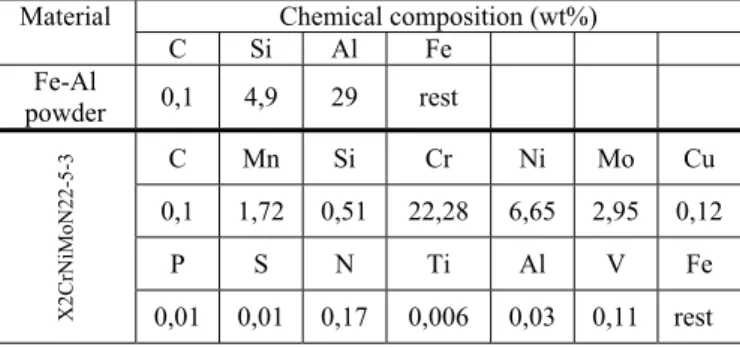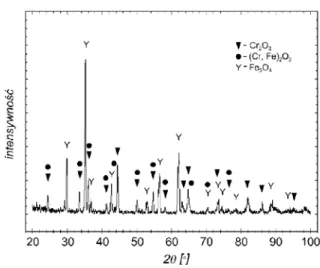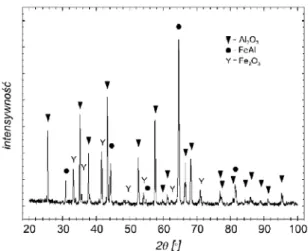A R C H I V E S O F F O U N D R Y E N G I N E E R I N G V o l u m e 1 1 , S p e c i a l I s s u e 2 / 2 0 1 1 , 5 – 8 5
A R C H I V E S
O f
F O U N D R Y E N G I N E E R I N G
Published quarterly as the organ of the Foundry Commission of the Polish Academy of Sciences
ISSN (1897-3310)
Volume 11
Special Issue
2/2011
5–8
1/2
The studies of scale surface produced
on outer diffusion layers
J. Augustyn-Pieni
ąż
ek
a,*, R. Zapa
ł
a
b aDepartment of Physical and Powder Metallurgy, Faculty of Metals Engineering and Industrial Computer Science, AGH
University of Science and Technology, al. Mickiewicza 30, 30-059 Cracow, Poland
b
Department of Cast Alloys and Composites Engineering, Faculty of Foundry Engineering,
AGH University of Science and Technology , Reymonta St. 23, 30-059 Cracow, Poland
*Corresponding autor: e-mail: jap@agh.edu.pl
Received 11.04.2011; Approved for print on: 26.04.2011
Abstract
In this study at attempt was made to examine the scale formed on ferritic-austenitic duplex type steel subjected to previous thermo-chemical treatment. The treatment consisted in diffusion aluminising in a metallising mixture composed of Fe-Al powder. As an activator, ammonium chloride (NH4Cl) added in an amount of 2 wt.% was used. Then, both the base material and samples with the diffusion-deposited surface layers were oxidised at 1000°C in the air. Thus formed scales were identified by light microscopy, SEM and X-ray phase analysis. The aim of the oxidation tests carried out under isothermal conditions was to compare the scale morphology when obtained on untreated substrate material and on the surface layers rich in aluminium.
Keywords: Diffusion aluminising, High-temperature corrosion, Scale morphology
1. Introduction
The basic characteristics of alloys for high temperature operation include resistance to aggressive environments, high mechanical properties at service temperatures and low manufacturing cost. Materials that combine these characteristics include, among others iron-based alloys, and alloy (cast) steels, in particular.
Although iron is characterised by relatively high melting point, its oxides formed in oxidising environments cannot provide an adequate protection at temperatures above 600 ºC [1]. Therefore, the alloy composition is enriched with additives of chromium, aluminium and silicon that are expected to improve the protective properties of the scale. In the case of oxide scales, the scale composed of Cr2O3 is generally thought to be the best one as regards its protective properties (besides α-Al2O3)) [2, 3].
To produce on the alloy surface, a compact, monophase, protective layer of Cr2O3, the chromium concentration in alloy
should be higher than the critical value above which the selective oxidation of metal occurs (the concentration of 20% Cr) [3, 4]. The developed iron-based alloys contain in their chemical composition sufficient amounts of chromium to create a protective layer of Cr2O3 resistant to the effect of both oxygen and air up to about 900°C [2]. However, chromium oxide Cr2O3 is stable only at low temperatures. Under the conditions of high-temperature oxidation, chromium oxide Cr2O3 reacts with oxygen to form a volatile oxide CrO3. This process occurs very intensely at high temperatures and at a high partial pressure of oxygen (close to the atmospheric one) [5].
The chromium oxides grows with diffusion of chromium cations outward and the cation defects move inward [6, 7]. On the scale/metal phase boundary, some discontinuities (pores and holes) are formed, that reduce the scale adhesion to the substrate.
A R C H I V E S O F F O U N D R Y E N G I N E E R I N G V o l u m e 1 1 , S p e c i a l I s s u e 2 / 2 0 1 1 , 5 – 8
6
metal is exposed to further oxidation within the area of the crack. Chromium oxides are formed again in these areas. When these processes are repeated, chromium content in the surface layer of metallic core decreases and material loses its resistance to the effect of high temperatures.
This contributes to the rapid growth of iron and nickel oxides and further intensification of the scale detachment [8].
The advanced materials for future structural applications are intermetalics. Good mechanical properties, also at elevated temperatures, high resistance to oxidation and corrosion in aggressive environments, and high resistance to abrasion recommend intermetals with all their valuable performance properties to be used as a material for protective surface layers [9, 10, 11].
Alloys containing intermetallic phases from the Fe-Al system belong to the class of materials that pose no technological problems during melting and casting. The high content of Al in Fe-Al alloys is responsible for the formation of a thin oxide coating of Al2O3 on the surface of the liquid metal, which protects this metal from the effect of the outer atmosphere [12, 13].
2. Methods of investigation
The tested material consisted of samples of the X2CrNiMoN22-5-3 ferritic-austenitic duplex steel (Fig. 1a), which have been aluminised in FeAl powder at a temperature of 900oC for 6 hours (Fig. 1b). The alloy powders used in the presented experiment were formed in the process of self-decomposition of high-aluminium alloy. As a result of this decomposition, based on intermetallic phases of Fe-Al, the structure of a secondary solution was obtained. The chemical composition of the tested powder and of the material subjected to aluminising is shown in Table 1. The oxidation rate of the examined materials under the isothermal conditions was determined on a LABSYSTM Setaram equipment. Dimensions of the examined samples were 4x3x2,5 mm. The oxidation process was carried out in accordance with the following parameters:
¾ oxidising temperature: 1000o C,
¾ sample heating rate: 50o/min,
¾ holding time: 15 hours,
¾ type of atmosphere: laboratory air at a pressure p=1bar). Table 1.
The chemical composition of Fe-Al powder and X2CrNiMoN22-5-3 steel examined
Chemical composition (wt%) Material
C Si Al Fe
Fe-Al
powder 0,1 4,9 29 rest
C Mn Si Cr Ni Mo Cu
0,1 1,72 0,51 22,28 6,65 2,95 0,12
P S N Ti Al V Fe
X2
Cr
NiM
o
N2
2-
5-3
0,01 0,01 0,17 0,006 0,03 0,11 rest
To describe the morphology of the scale produced on the tested material the following examinations were made:
microscopic examinations under an Axiovert 200 MAT light microscope made by Carl-Zeiss with KS 300 software,
microscopic examinations under a Hitachi S-3500N scanning electron microscope equipped with EDS system for X-ray microanalysis made by IXRF,
X-ray structural examinations carried out on a Bruker D8 Advance diffractometer using filtered radiation of cobalt anode tube (λKα = 1,79Å) and Siemens D500 diffractometer producing monochromatic radiation of a tube with copper anode (λKα = 1,54Å). The measurement conditions were as follows: angle step Δ2θ = 0,02°, count time τ =5÷10 seconds, angle measuring range 2θ = 20÷120°.
3. Results and discussion
Figure 1a shows an example of the microstructure obtained in substrate material, which was the examined duplex type steel, while Figure 1b shows microstructure of the surface layer obtained on the same steel during thermo-chemical treatment (aluminizing). The diffraction pattern enabled phase identification in the examined samples.
Fig. 1 Microstructure on cross-section of ferritic-austenitic duplex type steel: a) substrate material, b) outer layer rich in aluminium, c) diffraction patterns of substrate and outer layer with phase identification
The diffraction pattern of the substrate material showed the presence of peaks originating from the Feα and Feγ phases, while in the case of duplex steel with a diffusion surface layer, strong peaks from the Fe2Al5 and FeAl phases were observed. A small shift of diffraction lines towards the higher values of dhkl (smaller θ) was observed. It was the result of a changing lattice constant due to the changing chemical composition.
A R C H I V E S O F F O U N D R Y E N G I N E E R I N G V o l u m e 1 1 , S p e c i a l I s s u e 2 / 2 0 1 1 , 5 – 8 7 material and 0,0097 mg/mm2 for the sample with an outer layer
enriched in iron aluminide.
On the surface of non-aluminised samples, the presence of a dark-coloured layer of the high-temperature corrosion products was noticed. The scale was damaged with cracks but no detachment from the metallic core occurred (Fig. 2a).
The scale formed on samples with the aluminium-rich outer diffusion layer had a typical bright colour. It is worth noting that this layer has a highly developed surface. In inner part of the examined sample, spalling of the scale was observed; probably it was due to cooling of samples from the oxidation temperature.
Fig. 2 The appearance of ferritic-austenitic duplex type steel sample surface subjected to high-temperature oxidation corrosion: a) substrate material; b) sample with outer diffusion layer
The scale produced on dual-phase steel substrate was characterised by well developed surface composed of crystalline forms of a regular shape (Fig. 3). The EDS analysis revealed the presence of oxygen precipitates and significant amount of elements such as Cr and Fe.
Element Content
(atom%)
Content (wt%)
Error (wt%)
O 49,51 22,80 ± 1,10
Cr 32,06 47,99 ± 1,56
Fe 18,43 29,21 ± 1,89
Fig. 3. SEM image of surface morphology of the scale formed on ferritic-austenitic duplex type steel substrate after oxidising at 1000ºC for 15 hours
The X-ray qualitative phase analysis allowed detecting in the scale formed on substrate material the presence of peaks of the following phases: Cr2O3, Fe3O4 and (Cr,Fe)2O3 (Fig. 4). The presence of iron compounds in the scale is due to the fact that at temperatures above 950 °C chromium scale loses its stability, starts cracking and undergoes delamination. Cracks formed in the scale facilitate the diffusion of iron ions from the metallic core, and the protective layer composed of Cr2O3 is enriched with the Fe3O4 iron [8].
Fig. 4. Diffraction patterns obtained in samples of ferritic-austenitic duplex type steel oxidised at 1000oC – the appearance of substrate material
Element Content (atom%)
Content (wt%)
Error (wt%)
Al 36,12 48,34 ± 0,75
O 63,38 50,30 ± 1,30
Fe 0,37 1,04 ± 0,51
Fig. 5 SEM image of surface morphology of the scale formed on duplex steel with outer diffusion layer subjected to oxidising at 1000oC for 15 hours
The scale produced on a metallic core material with outer diffusion layer did not form a compact film of uniform thickness (Fig. 5). The EDS analysis detected in the precipitates the presence of elements such as iron, aluminum and oxygen.
A R C H I V E S O F F O U N D R Y E N G I N E E R I N G V o l u m e 1 1 , S p e c i a l I s s u e 2 / 2 0 1 1 , 5 – 8
8
Fig. 6. Diffraction patterns obtained in samples of ferritic-austenitic duplex type steel oxidised at 1000oC a) substrate material; b) material with outer diffusion layer
4. Conclusions
The studies have led to the following conclusions:
• samples with the outer diffusion layer rich in iron aluminide were characterised by higher resistance to the effect of corrosive environment.
• on the surface of the duplex steel not subjected to the process of aluminising, the scale formed is mainly composed of chromium oxide Cr2O3; on the same steel subjected to aluminising process, a layer composed of Al2O3 is formed characterised by higher stability at elevated temperatures,
• the Al2O3 layer has a tendency to cracking during cooling of the alloy,
• the presence of aluminium in metal alloys protects them from corrosion by producing passive and thin oxide films,
• the presence of aluminium atoms in solid solution or the presence of iron aluminides in outer layers result in the improved corrosion resistance properties.
Acknowledgements
The research has been executed under a Statutory work no 11.11.110.007
References
[1] F.H. Stott, Influence of alloy additions on oxidation, Materials Science and Technology, vol. 5 No. 8 (1989) 734-740.
[2] D. Landolt, Corrosion and surface chemistry of metals, Lausanne: EPFL Press (2007).
[3] P. Kofstad, High temperature corrosion, London, New York, Elsevier Applied Science (1988).
[4] S. Mrowec, Kinetyka i mechanizm utleniania metali, Wyd. 3. Katowice, Wydaw. ląsk (1982) (in Polish).
[5] A. S. Khanna, Introduction to high temperature oxidation and corrosion, Materials Park ASM International (2002).
[6] P. Kofstad, K. P. Lillerud, Chromium transport through Cr sub 2 O sub 3 scales. I. On lattice diffusion of chromium, Oxidation of Metals vol. 17, No. 3/4 (1982) 177-194.
[7] K.P. Lillerud, P. Kofstad, Chromium transport through Cr sub 2 O sub 3 Scales. II. Changes in scale morphology during high-vacuum treatment of oxidized chromium specimens, Oxidation of Metals vol. 17, No. 3/4 (1982) 195-203.
[8] M. Trokar, M. Godec, M. Lamut, Origin of flakes on stainless steel heater, Enginnering Failure Analysis No. 14 (2007) 1218-1223.
[9] S. Kobayashi, T. Yakou, Control of intermetallic compound layers at interface steel and aluminum by diffusion-treatment, Materials Science and Engineering, vol. A338 (2002) 44÷53. [10] K. Murakami, N. Nishida, K. Osamura , Y. Tomota, T. Suzuki, Aluminization of high purity iron and stainless steel by powder liquid coating, Acta Materialia vol. 52 (2004) 2173÷2184. [11] T. L. Hu, H. L. Huang, D. Gan, T. Y. Lee, The microstructure of aluminized type 310 stainless steel, Surface & Coatings Technology vol. 201 (2006) 3502-3509.
[12] V. K. Sikka, D. Wilkening, J. Liebetrau, B. Mackey, Melting and casting of FeAl-based cast alloy, Materials Science and Engineering vol. A258 (1998) 229-235.
[13] J. Augustyn-Pieniążek, Rozprawa doktorska nt. Wła ciwo ci warstw wierzchnich zawierających fazy międzymetaliczne z układu Fe-Al, Kraków (2008) (in Polish).
[14] Y. Y. Chang, Ch. Tsaur, J. Rock, Microstructure studies of an aluminide coating on 9Cr-1Mo steel during high temperature oxidation, Surface a. Coating Technology vol 200 (2006), 6588-6593.


